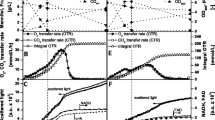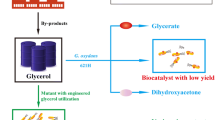Abstract
D-xylose is one of the most abundant carbohydrates in nature. This work focuses on xylose metabolism of Gluconobacter oxydans as revealed by a few studies conducted to understand xylose utilization by this strain. Interestingly, the G. oxydans 621H Δmgdh strain (deficient in membrane-bound glucose dehydrogenase) was greatly inhibited when grown on xylose and no xylonate accumulation was observed in the medium. These experimental observations suggested that the mgdh gene was responsible for the conversion of xylose to xylonate in G. oxydans, which was also verified by whole-cell biotransformation. Since 621H Δmgdh could still grow on xylose in a very small way, two seemingly important genes in the oxo-reductive pathway for xylose metabolism, a xylitol dehydrogenase-encoding gox0865 (xdh) gene and a putative xylulose kinase-encoding gox2214 (xk) gene, were knocked out to investigate the effects of both genes on xylose metabolism. The results showed that the gox2214 gene was not involved in xylose metabolism, and there might be other genes encoding xylulose kinase. Though the gox0865 gene played a less important role in xylose metabolism compared to the mgdh gene, it was significant in xylitol utilization in G. oxydans, which meant that gox0865 was a necessary gene for the oxo-reductive pathway of xylose in vivo. To sum up, when xylose was used as the carbon source, the majority of xylose was directly oxidized to xylonate for further metabolism in G. oxydans, whereas only a minor part of xylose was metabolized by the oxo-reductive pathway.







Similar content being viewed by others
References
Bu S, Tsang PWK, Fu RZ (2005) GroEL-GroES solubilizes abundantly expressed xylulokinase in Escherichia coli. J Appl Microbiol 98(1):210–215
Buchert J, Viikari L (1988) Oxidative D-xylose metabolism of Gluconobacter oxydans. Appl Microbiol Biotechnol 29(4):375–379
David JD, Wiesmeyer H (1970) Control of xylose metabolism in Escherichia coli. Biochim Bioph Acta 201(3):497
Deppenmeier U, Ehrenreich A (2009) Physiology of acetic acid bacteria in light of the genome sequence of Gluconobacter oxydans. J Mol Microbiol Biotechnol 16(1–2):69–80
Derbise A, Lesic B, Dacheux D, Ghigo JM, Carniel E (2003) A rapid and simple method for inactivating chromosomal genes in Yersinia. FEMS Immunol Med Mic 38(2):113–116
Erlandson KA, Delamarre SC, Batt CA (2001) Genetic evidence for a defective xylan degradation pathway in Lactococcus lactis. Appl Environ Microb 67(4):1445–1452
Gírio FM, Pelica F, Amaral MT (1996) Characterization of xylitol dehydrogenase from Debaryomyces hansenii. Appl Biochem Biotech 56(1):79–87
Greenfield S, Claus GW (1972) Nonfunctional tricarboxylic acid cycle and the mechanism of glutamate biosynthesis in Acetobacter suboxydans. J Bacteriol 112(3):1295–1301
Gu Y, Ding Y, Ren C, Sun Z, Rodionov DA, Zhang WW, Yang S, Yang C, Jiang WH (2010) Reconstruction of xylose utilization pathway and regulons in Firmicutes. BMC Genomics 11(1):255
Hölscher T, Görisch H (2006) Knockout and overexpression of pyrroloquinoline quinone biosynthetic genes in Gluconobacter oxydans 621H. J Bacteriol 188(21):7668–7676
Hartree EF (1972) Determination of protein: a modification of the Lowry method that gives a linear photometric response. Anal Biochem 48(2):422–427
Jeffries TW (2006) Engineering yeasts for xylose metabolism. Curr Opin Biotech 17(3):320–326
Johnsen U, Dambeck M, Zaiss H, Fuhrer T, Soppa J, Sauer U, Schönheit P (2009) D-xylose degradation pathway in the halophilic archaeon Haloferax volcanii. J Biol Chem 284(40):27290–27303
Lindner C, Stülke J, Hecker M (1994) Regulation of xylanolytic enzymes in Bacillus subtilis. Microbiol 140(4):753–757
Pival SL, Birner-Gruenberger R, Krump C, Nidetzky B (2011) D-xylulose kinase from Saccharomyces cerevisiae: isolation and characterization of the highly unstable enzyme, recombinantly produced in Escherichia coli. Protein Expres Purif 79(2):223–230
Prust C, Hoffmeister M, Liesegang H, Wiezer A, Fricke WF, Ehrenreich A, Gottschalk G, Deppenmeier U (2005) Complete genome sequence of the acetic acid bacterium Gluconobacter oxydans. Nat Biotechnol 23(2):195–200
Stephen Dahms A (1974) 3-deoxy-D-pentulosonic acid aldolase and its role in a new pathway of D-xylose degradation. Biochem Bioph Res Co 60(4):1433–1439
Stephens C, Christen B, Fuchs T, Sundaram V, Watanabe K, Jenal U (2007) Genetic analysis of a novel pathway for D-xylose metabolism in Caulobacter crescentus. J Bacteriol 189(5):2181–2185
Sugiyama M, Suzuki S, Tonouchi N, Yokozeki K (2003) Cloning of the xylitol dehydrogenase gene from Gluconobacter oxydans and improved production of xylitol from D-arabitol. Biosci Biotech Bioch 67(3):584–591
Weimberg R (1961) Pentose oxidation by Pseudomonas fragi. J Biol Chem 236(3):629–635
Yang C, Hua Q, Baba T, Mori H, Shimizu K (2003) Analysis of Escherichia coli anaplerotic metabolism and its regulation mechanisms from the metabolic responses to altered dilution rates and phosphoenolpyruvate carboxykinase knockout. Biotechnol Bioeng 84(2):129–144
Zhu K, Lu LF, Wei LJ, Wei DZ, Imanka T, Hua Q (2011) Modification and evolution of Gluconobacter oxydans for enhanced growth and biotransformation capabilities at low glucose concentration. Mol Biotechnol 49(1):56–64
Acknowledgments
This study was financially supported by the National Natural Science Foundation of China (No. 31200025), National Basic Research Program of China (973 Program) (2012CB721101), Natural Science Foundation of Shanghai (11ZR1408100), and partially supported by National Special Fund for State Key Laboratory of Bioreactor Engineering (2060204), Shanghai Leading Academic Discipline Project (B505) and the Fundamental Research Funds for the Central Universities.
Author information
Authors and Affiliations
Corresponding author
Additional information
Minhua Zhang and Liujing Wei contributed equally to this work.
Rights and permissions
About this article
Cite this article
Zhang, M., Wei, L., Zhou, Y. et al. Genetic analysis of D-xylose metabolism pathways in Gluconobacter oxydans 621H. J Ind Microbiol Biotechnol 40, 379–388 (2013). https://doi.org/10.1007/s10295-013-1231-4
Received:
Accepted:
Published:
Issue Date:
DOI: https://doi.org/10.1007/s10295-013-1231-4




